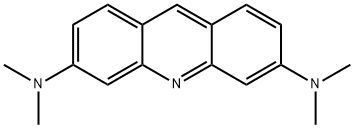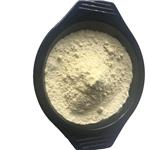Description
Acridine orange is a cell-permeable, nucleic acid-selective fluorescent cationic dye useful for cell cycle determination and detection of cellular autophagy. It exhibits excitation/emission spectra of 502/525, 460/650, and 475/590 nm when bound to dsDNA, bound to ssDNA or RNA, and under acidic conditions, respectively. The ratio of acridine orange emission at 590 to emission at 525 nm can be used to quantify the increase in the number of acidic vesicular organelles observed during cellular autophagy.
Uses
Acridine Orange Stain is a fluorescent nucleic acid binding dye which interacts with both DNA and RNA. When bound to DNA, it emits green fluorescence (Em=525 nm) and when bound to RNA, it emits red fluorescence (Em=~650 nm).
Definition
ChEBI: A member of the class of aminoacridines that is acridine carrying two dimethylamino substituents at positions 3 and 6. The hydrochloride salt is the fluorescent dye 'acridine orange', used for cell cycle determination.
Preparation
4,4′-Bis(N,N-dimethyl)aminodiphenylmethane?dinitration, the resultant 4-(4-(Dimethylamino)-3-nitrobenzyl)-N,N-dimethyl-2-nitrobenzenamine?reduction, and acid heating will diamino compound cyclization, then will product oxidation and made free base.
Safety Profile
Poison by subcutaneous route.Questionable carcinogen with experimental tumorigenicand carcinogenic data. Mutation data reported. Whenheated to decomposition it emits toxic fumes of NOx.
Purification Methods
The double salt with ZnCl2 (6g) is dissolved in water (200mL) and stirred with four successive portions (12g each) of Dowex-50 ion-exchange resin (K+ form) to remove the zinc. The solution is then concentrated in vacuum to 20mL, and 100mL of ethanol is added to precipitate KCl which is removed. Ether (160mL) is added to the solution from which, on chilling, the dye crystallises as its chloride. It is separated by centrifugation, washed with chilled ethanol and ether, and dried under vacuum, before being recrystallised from ethanol (100mL) by adding ether (50mL), and chilling. Yield 1g. [Pal & Schubert J Am Chem Soc 84 4384 1962]. It was recrystallised twice as the free base from ethanol or methanol/water by dropwise addition of NaOH (less than 0.1M). The precipitate was washed with water and dried under vacuum. It was dissolved in CHCl3 and chromatographed on alumina: the main sharp band was collected, concentrated and cooled to -20o. The precipitate was filtered off, dried in air, then dried for 2hours under vacuum at 70o. [Stone & Bradley J Am Chem Soc 83 3627 1961, Blauer & Linschitz J Phys Chem 66 453 1962, Albert J Chem Soc 244 1947, Beilstein 22 III/IV 5490, 22/11 V 326.]
Properties and Applications
brilliant yellow orange. Soluble in water and ethanol as orange, with green fluorescence. In concentrated sulfuric acid in almost colorless, with green fluorescent, dilution after orange. Dye aqueous solution to join sodium hydroxide have yellow precipitation.
|
Standard
|
Light Fastness
|
Heat-resistant(℃)
|
water
|
Sodium Carbonate(5%)
|
Hydrochloric acid(5%)
|
|
Melting point
|
Stable
|
|
ISO
|
Poor
|
|
|
Poor
|
|
|



